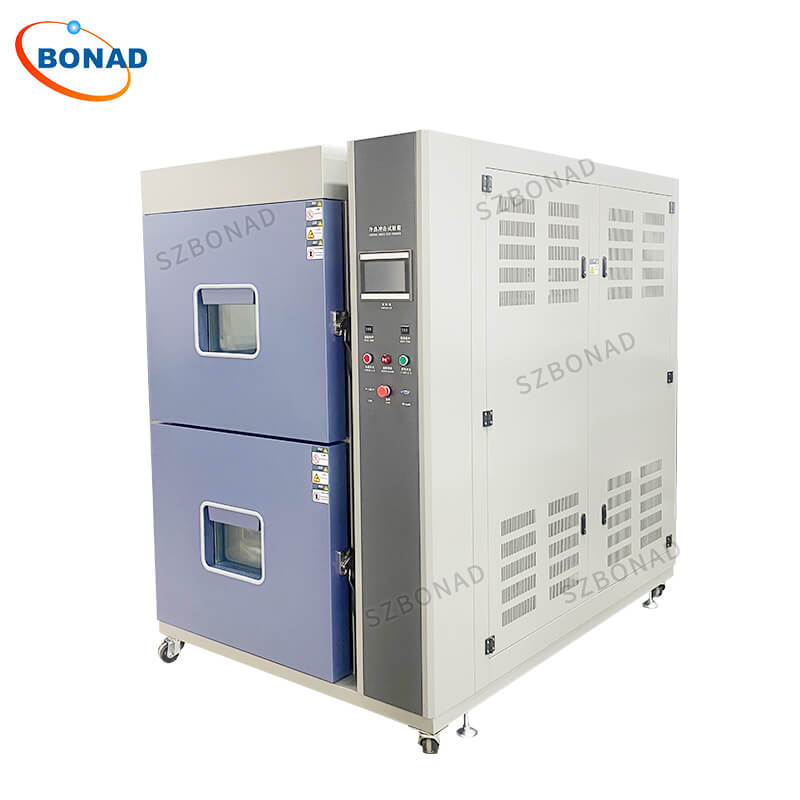Enhancing Product Environmental Adaptability with Thermal Shock Test Chambers
In contemporary product development, ensuring environmental adaptability is paramount for product reliability and longevity. Many industries utilize thermal shock test chambers to simulate extreme temperature variations, testing how products endure rapid temperature changes. These tests, which replicate sudden heating and cooling cycles, are essential in fields such as electronics, automotive, aerospace, and materials science. This article delves into the principles of thermal shock test chambers, key technologies involved, and their crucial role in improving product adaptability.
1. Principles of Thermal Shock Test Chambers
Thermal shock test chambers are generally divided into two zones: a high-temperature zone and a low-temperature zone. During testing, products are swiftly moved between these zones to mimic severe temperature fluctuations. This process subjects the samples to an accelerated “aging” effect similar to real-world environmental stresses.
Zone Switching: Within the chamber, samples transition between hot and cold zones, allowing materials to undergo rapid “thermal expansion and contraction” cycles, simulating real-life temperature shock scenarios.
Heat Conduction and Exchange Efficiency: High-quality thermal shock test chambers feature highly efficient heat exchange systems that ensure uniform and rapid temperature switching.
2. Key Technical Features of Thermal Shock Test Chambers
To achieve accurate results and maintain device durability, thermal shock test chambers incorporate advanced technology. Here are some core features:
Fast Temperature Switching: High-performance test chambers can switch zones within seconds, maximizing the ability to simulate real environmental conditions.
Temperature Uniformity and Stability: Unlike standard temperature test devices, thermal shock chambers require high temperature uniformity, achieved through advanced airflow systems and precision sensors.
Durability and Shock Resistance: Built with high-durability materials that withstand extreme fluctuations, these test chambers ensure long-term stability during repeated temperature cycling.
Data Collection and Analysis: Modern thermal shock chambers offer data collection systems that monitor temperature variations and testing duration in real-time, often supporting remote access for comprehensive data analysis.
3. Applications of Thermal Shock Testing in Enhancing Product Environmental Adaptability
Thermal shock test chambers are widely used across various sectors to assess environmental adaptability and longevity. Below are examples of how different industries benefit from this testing:
Electronics and Semiconductor Industry
Electronic components are particularly vulnerable to temperature changes, which can lead to solder joint cracks or chip failure. Thermal shock testing replicates rapid “thermal fatigue” conditions for electronic devices, ensuring that products like smartphones and industrial controllers maintain reliable performance in varied climates.
Automotive Industry
In the automotive sector, thermal shock testing helps verify the adaptability of engine components, plastic parts, and seals. For instance, rapid temperature cycles simulate the effects of extreme summer heat or winter cold, allowing manufacturers to assess material resilience against cracking or warping.
Aerospace Industry
Aerospace components frequently experience sudden temperature shifts due to changes in altitude and airflow. Thermal shock testing simulates these fluctuations, verifying the durability of critical mechanical, electronic, and structural components—crucial for both safety and performance.
Materials Science and Research
In materials science, thermal shock testing is instrumental in studying how materials respond to rapid temperature changes. Testing data informs the design of new materials that can withstand specific temperature ranges, supporting advancements in everything from construction materials to automotive alloys.
4. Testing Process and Data Interpretation
Thermal shock testing requires precise data collection and interpretation to provide actionable insights. The general process involves the following steps:
Sample Preparation: Before testing begins, samples are often cleaned or pretreated to eliminate impurities and ensure accuracy.
Temperature and Time Control: Set high- and low-temperature limits based on testing needs. Test duration and switching speed must follow industry standards to replicate real conditions.
Data Collection and Monitoring: Throughout the test, data on temperature variations, stress levels, and material changes is collected for analysis.
Results Analysis: Analyze results to assess the product’s performance under thermal shock conditions—looking for any cracks, deformations or joint failures—and interpret data using established standards for better understanding of product resilience.
5. Using Thermal Shock Testing Results for Product Design Optimization
Thermal shock testing provides critical data that guides improvements in product design. Through analysis companies can enhance structural design as well as material selection:
Material Selection: Components prone to cracking or warping during tests can be replaced with materials optimized for thermal stability.
Structural Optimization: For areas affected by stress concentration structural adjustments can reduce damage from expansion/contraction cycles.
Process Improvements: Enhanced welding techniques or high-temperature soldering can improve joint integrity reducing risk of failure during thermal cycling.
By leveraging insights gained from thermal shock testing companies across various industries can significantly enhance their products’ environmental adaptability ensuring better performance reliability durability over time.



